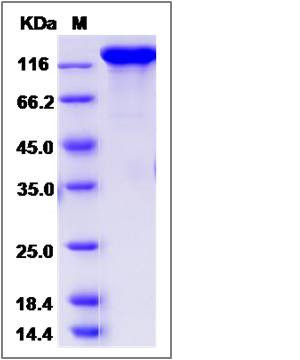Rat Contactin 3 / CNTN3 Protein (His Tag)
CNTN3
- 100ug (NPP3020) Please inquiry
| Catalog Number | P80316-R08H |
|---|---|
| Organism Species | Rat |
| Host | Human Cells |
| Synonyms | CNTN3 |
| Molecular Weight | The recombinant rat CNTN3 comprises 993 amino acids and predicts a molecular mass of 109.2 kDa. The apparent molecular mass of the recombinant protein is approximately 120 kDa in SDS-PAGE under reducing conditions due to glycosylation. |
| predicted N | Glu 20 |
| SDS-PAGE |  |
| Purity | > 95 % as determined by SDS-PAGE |
| Protein Construction | A DNA sequence encoding the rat CNTN3 (Q62682) (Met1-Gly1001) was expressed, fused with a polyhistidine tag at the C-terminus. |
| Bio-activity | |
| Research Area | Signaling |Signal Transduction |Metabolism |Types of disease |Metabolism in Cancer |
| Formulation | Lyophilized from sterile PBS, pH 7.4 1. Normally 5 % - 8 % trehalose, mannitol and 0.01% Tween80 are added as protectants before lyophilization. Specific concentrations are included in the hardcopy of COA. |
| Background | Contactins are a subgroup of molecules belonging to the immunoglobulin superfamily that are expressed exclusively in the nervous system. The subgroup consists of six members: Contactin-1, Contactin-2(TAG-1), Contactin-3(BIG-1), BIG-2, Contactin-5(NB-2) and NB-3. Since their identification in the late 1980s, Contactin-1 and Contactin-2 have been studied extensively. Axonal expression and the neurite extension activity of Contactin-1 and Contactin-2 attracted researchers to study the function of these molecules in axon guidance during development. Contactin-1 and Contactin-2 have come to be known as the principal molecules in the function and maintenance of myelinated neurons. In contrast, the function of the other four members of this subgroup remained unknown until recently. Contactin-3, also known as CNTN3 ( BIG-1 in rat and PANG in mouse ), is a GPI-linked glycoprotein that is expressed on cerebellar Purkinje cells, amygdaloid and thalamic neurons and olfactory granule cells. In the brain, Contactin-3 is expressed in frontal lobe, occipital lobe, cerebellum and amygdala. Contactin-3 contains 4 fibronectin type-III domains and 6 Ig-like C2-type (immunoglobulin-like) domains. Human Contactin-3 shares 92% aa identity with mouse Contactin-3.The exact function of Contactin-3 is unclear. Contactin-3 may mediate cell-cell interaction and may promote neurite outgrowth. |
| Reference |
